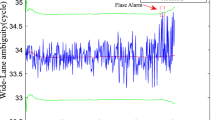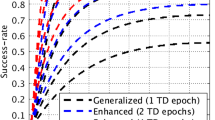Abstract
The modernization of the global positioning system and the advent of the European project Galileo will lead to a multifrequency global navigation satellite system (GNSS). The presence of new frequencies introduces more degrees of freedom in the GNSS data combination. We define linear combinations of GNSS observations with the aim to detect and correct cycle slips in real time. In particular, the detection is based on five geometry-free linear combinations used in three cascading steps. Most of the jumps are detected in the first step using three minimum-noise combinations of phase and code observations. The remaining jumps with very small amplitude are detected in the other two steps by means of two-tailored linear combinations of phase observations. Once the epoch of the slip has been detected, its amplitude is estimated using other linear combinations of phase observations. These combinations are defined with the aim of discriminating between the possible combinations of jump amplitudes in the three carriers. The method has been tested on simulated data and 1-second triple-frequency undifferenced GPS data coming from a friendly multipath environment. Results show that the proposed method is able to detect and repair all combinations of cycle slips in the three carriers.













Similar content being viewed by others
References
Bakker PF de, Tiberius CJM, van der Marel H, van Bree RJP (2011) Short and zero baseline analysis of GPS L1 C/A, L5Q, GIOVE E1B, and E5aQ signals. GPS Solut. doi:10.1007/s10291-011-0202-3 (published on line)
Banville S, Langley RB (2010) Instantaneous cycle slips correction for real time PPP applications. Navigation 57(4):325–334
Beutler G, Bock H, Brockmann E, Dach R, Fridez P, Gurtner W, Habrich H, Hugentobler U, Ineichen D, Jaeggi A, Meindl M, Mervart L, Rothacher M, Schaer S, Schmid R, Springer T, Steigenberger P, Svehla D, Thaller D, Urschl C, Weber R (2006) BERNESE GPS software version 5.0
Bisnath SB, Langley RB (2000) Automated cycle-slip correction of dual-frequency kinematic GPS data. In: Proceedings of 47th conference of CASI, Ottawa, Canada
Blewitt G (1990) An automatic editing algorithm for GPS Data. Geophys Res Lett 17(3):199–202
Cocard M, Bourgon S, Kamali O, Collins P (2008) A systematic investigation of optimal carrier-phase combinations for modernized triple-frequency GPS. J Geod 82:55–564. doi:10.1007/s00190-007-0201-x
Dai Z, Knedlik S, Loffeld O (2009) Instantaneous triple-frequency GPS cycle-slip detection and repair. Int J Navig Obs. Article ID 407231. doi:10.1155/2009/407231
Euler HJ, Goad CC (1991) On optimal filtering of GPS dual frequency observations without using orbit information. Bull Geodesique 65:130–143
Feng Y (2008) GNSS three carrier ambiguity resolution using ionosphere-reduced virtual signal. J Geod 82(12):847–862
Feng Y, Rizos C (2009) Network-based geometry-free three carrier ambiguity resolution and phase bias calibration. GPS Solut 13(1):43–56. doi:10.1007/s10291-008-0098-8
IS-GPS-200 (2010) Global positioning system wing (GPSW) systems engineering and integrations. Available at http://www.gps.gov/technical/icwg/
IS-GPS-705 (2010) Global positioning system wing (GPSW) systems engineering and integrations. Available at http://www.gps.gov/technical/icwg/
Ji S, Chen W, Zhao C, Ding X, Chen Y (2007) Single epoch ambiguity resolution for Galileo with the CAR and LAMBDA methods. GPS Solut 11(4):259–268
Kim D, Langley RB (2001) Instantaneous real-time cycle-slip correction of dual frequency GPS data. In: Proceedings of the international symposium on kinematic systems in geodesy, geomatics and navigation, pp 255–264
Lacy MC de, Reguzzoni M, Sansò F, Venuti G (2008). The Bayesian detection of discontinuities in a polynomial regression and its application to the cycle slip problem. J Geod 82(9):527–542
Lee HK, Wang J, Rizos C (2003) Effective cycle slip detection and identification for high precision GPS/INS integrated systems. J Navig 56(3):475–486. doi:10.1017/S0373463303002443
Li B, Feng Y, Shen Y (2010) Three carrier ambiguity resolution: distance-independent performance demonstrated using semi-generated triple frequency GPS signals. GPS Solut 14(2):177–184
Lichten SM, Bar-Sever YE, Bertiger EI, Heflin M, Hurst K, Muellerschoen RJ, Wu SC, Yunck TP, Zumberge JF (1995) GIPSY-OASIS II: a high precision GPS data processing system and general orbit analysis tool, technology 2006, NASA Technology Transfer Conference, Chicago, Illinois, 24–26 October 1995
Liu Z (2011) A new automated cycle slip detection and repair method for a single dual-frequency GPS receiver. J Geod 85:171–183. doi:10.1007/s00190-010-0426-y
Odijk D (2003) Ionosphere-free phase combinations for modernized GPS. J Survey Eng 129(4):165–173
O’Keefe K, Julien O, Cannon ME, Lachapelle G (2005) Availability, accuracy, reliability, and carrier-phase ambiguity resolution with Galileo and GPS. Acta Astronautica 58(8):422–434
OS SIS ICD (2010) European GNSS (Galileo) open service. Signal in space. Interface control document. Issue 1.1. Available at http://ec.europa.eu/enterprise/policies/satnav/galileo
Richert T, El-Sheimy N (2007) Optimal linear combinations of triple frequency carrier phase data from future global navigation satellite systems. GPS Solut 11:11–19
Teunissen PJG, Bakker PF de (2009). Next generation GNSS single receiver cycle slip reliability. Proceedings of the VII Hotine-Marussi Symposium, Rome, Italy, 6–10 July 2009. In print
Teunissen PJG, Odijk D (2003) Rank defect integer estimation and phase-only modernized GPS ambiguity resolution. J Geod 76(9–10):259–268
Zhen D, Stefan K, Otmar L (2008) Realtime cycle slip detection and determination for multiple frequency GNSS. In: Proceedings of the 5th workshop on positioning, navigation and communication 2008 (WPNC’08)
Acknowledgments
This study has been funded by the Spanish Government through the Research Project entitled ``Nuevos algoritmos para el futuro sistema GNSS multifrecuencia’’ with reference AYA2008-02948.
Author information
Authors and Affiliations
Corresponding author
Rights and permissions
About this article
Cite this article
de Lacy, M.C., Reguzzoni, M. & Sansò, F. Real-time cycle slip detection in triple-frequency GNSS. GPS Solut 16, 353–362 (2012). https://doi.org/10.1007/s10291-011-0237-5
Received:
Accepted:
Published:
Issue Date:
DOI: https://doi.org/10.1007/s10291-011-0237-5




